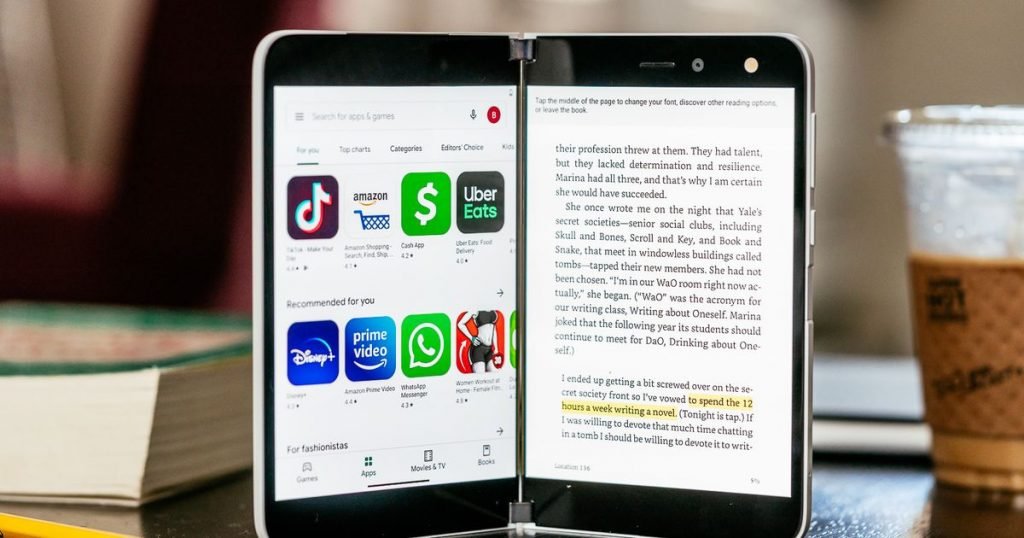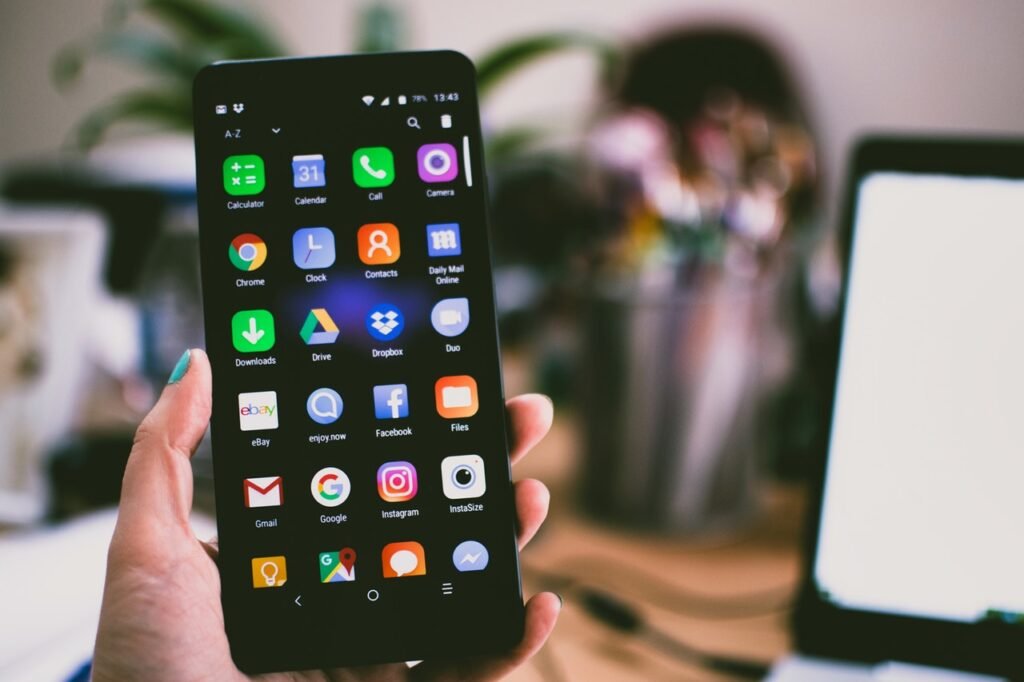Microsoft Surface Duo review: Is this the new normal?

Gorgeous design • Super lightweight and thin • Flexible and sturdy hinge • Compose / tent / book postures add versatility
Buggy • Lack of a front-facing notification panel • Lack of water resistance • Steep navigation learning curve • Hard to control one-handed
The Surface Duo is a right step in a different direction for Microsoft’s mobile efforts. This dual-screen Android device is far from perfect, but it’s a great starting point for what is surely to come.
The Surface Duo is an odd duck.
I’m not drinking the Microsoft marketing Kool-Aid when I say this, but this thing doesn’t feel like a phone, although it runs Android. It’s not even an effective tablet, thanks to that screen-swallowing metal hinge. No, this “thing” is more like a laptop with two connected, touchscreen monitors — except it’s not a sufficient laptop replacement. So what is it then?
It’s important to preface this review by scrubbing your brain of any “mobile phone” associations because, aside from the fact that you hold the Duo in your hands, the comparisons are not entirely appropriate. This is not an apples-to-apples situation; it’s more like apples-to-durian fruit. In my short time with the device, I’ve come to realize that it does rightly occupy its own space within the larger foldables category without actually being one of those full-fledged foldables. Its dual 5.6-inch 1800×1350 AMOLED screens open in a book-like manner to form a bisected 8.1-inch display, making the Duo an outlier — while its “cousins,” Samsung’s Galaxy Z Flip and Z Fold 2, embrace single bendable displays.
There’s one other inescapable thing about the Duo you’ll come to realize within your first few hours with it: a steep learning curve. You won’t use the Duo like you use your current phone, though you will try. Instead, the Duo will teach you how it wants to be used through trial and frustrating errors, most of which are navigation-based. But as with all new things, it’ll eventually become familiar and you’ll settle into a rhythm with it.
The question is whether it’s worth the hassle.
A premium feel to match the price
It’s a book. It’s a phone. It’s a … Surface Duo.
Image: zlata ivleva / mashable
Starting at $1,400, the Surface Duo is far from impulse-buy territory, but it’s also more affordably priced than something like the bank-breaking, $2,000 Galaxy Z Fold 2. Its Android core and related suite of pre-installed Google apps, including Gmail, Maps, and more, help to lower the risk/novelty factor some, allowing curious early adopters to dabble in Microsoft’s new Android-pond without ditching the mobile ecosystem their virtual lives have come to depend upon.
But that doesn’t mean Microsoft has ceded the show entirely to Google. The company’s left its imprint on the Duo, packing it with all of the Office apps you expect (i.e., Outlook, OneDrive, OneNote, Teams, OneDrive), plus others like Skype, LinkedIn, and Edge.
For the price, Microsoft is giving users 128GB of storage — upgradeable to 256GB for an additional cost — paired with 6GB of RAM, a Snapdragon 855 CPU, and a 3,577mAh battery that never once posed a problem throughout my time testing the device. (In fact, I hardly worried about battery life at all since it lasted over 10 hours on a single charge with heavy use. Normal use gets you more than a day.)
All of this is housed inside of an elegantly thin and lightweight device that weighs just a little more than half a pound and measures just under 5mm when unfolded. This emphasis on a featherweight build means the Duo is truly portable — you can slide it easily into your pants pocket or toss it in a bag without weighing down your shoulder. But the Duo’s slight profile also works against it to a degree. By emphasizing thinness, the product team behind the Duo also sacrificed some much-needed convenience in the form of a front-facing notification panel.
This may seem like a minor design omission, but losing the ability to check notifications at a glance actually heightened my anxieties. I found myself reaching more often for the Duo, not because I wanted to play around with it, but because I was paranoid I’d missed an email or text. Microsoft has positioned this as the working professional’s device — you know, those multitasking A-types who have no problem emailing you after work hours, and are ready to respond to Slack pings while on the treadmill past 10pm on the weekend. And it’s done that group a disservice in this regard.
Sure, you could argue that a connected smartwatch would alleviate this pain point (and it’s possible many of those overachieving A-types already use one), but that’s not included in the box. So that excuse doesn’t really factor in here.
The Surface Duo “hinges” on this sturdy fella.
Image: zlata ivleva / mashable
I’d assumed the Duo’s “peek” posture, which allows you to slightly open the device to glance at the time, would rectify this misstep. I was wrong. This mode only shows the current time — that is when you manage to open the device to the exact degree to trigger it — not the number of unread emails and texts, or whatever other notifications you rely on. If you really want to know what you’ve been missing out on, you have to fully open the Duo. It’s not ideal. And that’s just the way it is.
Its convenience shortcomings notwithstanding, the Duo is undeniably a thing of beauty. It’s a solid, premium piece of engineering, and for that Microsoft deserves credit. You’ll know this cost $1,400 because it feels like it cost $1,400 — it’s just sturdy. And you can tell the Duo belongs to the Surface family, too, because of the minimalist design at work. When closed, the only noticeable embellishment is the silvery Windows logo on its front. The rest is a sea of glacier white that’s broken only by its silent 360-degree metal hinge.
Everything you need to physically control the Duo is placed along the right edge of the right display. Here is where you’ll find the reliable fingerprint sensor sandwiched between the volume rocker and power button above it, and the SIM card tray below. The USB-C port, which can be used for fast charging with the included 18W power supply or for connecting to a PC or laptop, lives on the bottom edge of the right display.
Assume the single-screen posture.
Image: zlata ivleva / mashable
As for its cameras, well… the Duo only has one. (I know — gasp, clutch your pearls, shake your head — whatever helps you process this departure from normalcy.) This lone 11-megapixel camera (f/2.0) sits above the right display and does double duty as your main and selfie cam, depending on the posture. Fold the left display back into single-screen mode with the right screen facing outwards, and you can shoot “rear” photos like you normally would with a regular smartphone. If you need to swap into selfie mode, just flip the Duo around and it should automatically adjust, lighting up the display you’re facing. This doesn’t always work seamlessly, however, and in those instances an onscreen prompt will instruct you to double-tap your desired display to “wake” it.
Your guide to ‘good’ postures
By now, you’ve surely come to realize that “posture” is just Microsoft’s fancy way of describing how you hold and fold the Duo. There are five of these modes to choose from — book, compose, single screen, tent, and peek — though I came to rely on just two.
Compose
Compose mode works best for scrolling through social media or watching Twitch.
Image: zlata ivleva / mashable
Of the bunch, the most enticing and useful posture is compose — but not for the reasons Microsoft intended. This mode allows you to flip the Duo into a laptop-like orientation, freeing up the bottom display to function as a fullscreen keyboard, with the “compose” window (for emails or texts) up top.
I managed to pleasantly while away a couple of hours with the Duo in this posture as I listened to Spotify on my Surface Earbuds and slowly thumb-typed out a journal entry. But the experience wasn’t without frustration. Due to the power button’s placement on the right side of the fingerprint sensor — a natural resting place for your right pinky finger when holding the Duo in the compose posture — I found that I kept accidentally triggering it and turning o
Be the first to write a comment.







